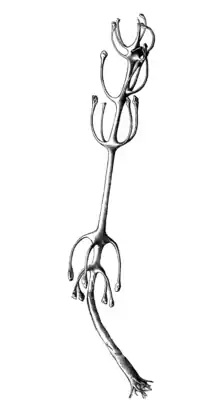| Chondrocladia concrescens | |
|---|---|
 | |
| 1888 illustration by Agassiz | |
| Scientific classification | |
| Domain: | Eukaryota |
| Kingdom: | Animalia |
| Phylum: | Porifera |
| Class: | Demospongiae |
| Order: | Poecilosclerida |
| Family: | Cladorhizidae |
| Genus: | Chondrocladia |
| Subgenus: | Chondrocladia |
| Species: | C. concrescens |
| Binomial name | |
| Chondrocladia concrescens (Schmidt, 1880)[1] | |
| Synonyms | |
| |
Chondrocladia concrescens (formerly Cladorhiza concrescens) is a species of deep-sea carnivorous sponge in the family Cladorhizidae. It is commonly known as the "ping pong tree sponge" due to its distinctive tree-like shape with multiple branches. The species is found in the eastern Pacific Ocean and can grow up to one meter in height.
Description
The ping pong tree sponge has a long stem-like holdfast that anchors it to the seafloor. From this holdfast, the sponge produces long, branching structures with nodes that give rise to clusters of four to six club-shaped appendages. The appendages are covered with tiny hooks that capture small crustaceans and other invertebrates, which the sponge feeds on. The species has a unique appearance that resembles a tree with multiple branches and is a distinguishing feature of the deep-sea ecosystem.
Reproduction
The ping pong tree sponge has a complex life cycle that involves both sexual and asexual reproduction. In the asexual phase, the sponge produces buds that eventually detach and settle on the seafloor, forming new colonies. In the sexual phase, the sponge produces eggs and sperm that are released into the water column, where they fertilize and develop into larvae that eventually settle on the seafloor and grow into new sponges.
Ecology
The ping pong tree sponge is an important component of deep-sea ecosystems, providing habitat and food for a variety of organisms. The sponge's feeding structures are covered with tiny hooks that capture small crustaceans and other invertebrates, making it a primary consumer in the deep-sea food web. Additionally, the sponge's unique branching structure provides shelter and refuge for a variety of other deep-sea species.
Conservation
The ping pong tree sponge, like many deep-sea species, is vulnerable to human activities such as deep-sea trawling and mining, which can damage or destroy the fragile seafloor habitats where the sponge lives. As a result, conservation efforts are underway to protect deep-sea ecosystems and the species that depend on them. The International Union for Conservation of Nature (IUCN) has listed the species as "Data Deficient," highlighting the need for further research and conservation efforts.
Discovery
C. concrescens was first discovered by Alexander Agassiz in 1869. Agassiz, a Swiss-American zoologist and marine biologist, observed the sponges during his expeditions in the deep sea. In his observations, he noted that the sponges had "a long stem ending in ramifying roots, sunk deeply into the mud. The stem has nodes with four to six club-like appendages. They evidently cover like bushes extensive tracts of the bottom." Agassiz's discovery of C. concrescens was a significant contribution to the field of deep-sea biology, as the sponge's unique shape and feeding structures were unlike any other sponge known at the time. The species was later rediscovered during the Eltanin expedition, a research cruise conducted by the US Navy in the Southern Ocean in 1962-1963. The expedition collected a variety of deep-sea organisms, including the "Eltanin Antenna", an unusual structure that was later confirmed to be an individual of the C. concrescens species. Today, the ping pong tree sponge remains an important subject of study for marine biologists, who continue to explore the mysteries of the deep-sea ecosystem.
See also
References
- ↑ Vacelet, J., van Soest, R. (2014). Van Soest RW, Boury-Esnault N, Hooper JN, Rützler K, de Voogd NJ, de Glasby BA, Hajdu E, Pisera AB, Manconi R, Schoenberg C, Janussen D, Tabachnick KR, Klautau M, Picton B, Kelly M, Vacelet J (eds.). "Chondrocladia (Chondrocladia) concrescens (Schmidt, 1880)". World Porifera database. World Register of Marine Species. Retrieved 2014-04-30.